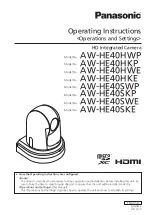
34
Camera Performance and Features
Setting Custom Flat Field Coefficients
Flat Field (PRNU) coefficients can be custom modified and uploaded to the camera. They can also
be downloaded from the camera.
To upload or download coefficients, use File
Access Control Category > Upload / Download File >
Settings
and then select
Miscellaneous > Current PRNU
to download / upload a file.
The PRNU coefficients are used by the camera as soon as they are uploaded. To avoid loss at
power up or while changing row settings, the uploaded coefficients should be saved to one of the
available user sets.
Flat Field Calibration Filter
See the section Flat Field Category in Appendix A for GenICam features associated with this section
and how to use them
Related Feature: Calibration Algorithm
If a sheet of material is being used as a white target, it must be completely free of blemishes and
texture.
The presence of dirt or texture will generate a variation in the image that will be incorporated into
the calibration coefficients of the camera. Further, once the target is removed, or moved, vertical
stripes will be present in the scanned image.
Dirt or texture that has dark characteristics will appear as bright vertical lines. Dirt or texture that
has bright characteristics will appear as dark vertical lines.
One way to minimize this effect is to have the white target in motion during the calibration process.
This has the result of averaging out any dirt or texture present. If this is not possible, the camera
has a feature where a flat field calibration filter can be applied while generating the flat field
correction coefficients—which can minimize the effects of dirt. Note that this filter is only capable of
compensating for small, occasional contaminants. It will not overcome large features in a target’s
texture.
Flat Field Calibration Regions of Interest
See the section Flat Field Category in Appendix A for GenICam features associated with this section
and how to use them
Related Features: flatfieldCalibrationROIOffsetX, flatfieldCalibrationROIWidth
There are occasions when the camera’s field of view includes areas that are beyond the material to
be inspected.
This may occur when cameras image off the edge of a panel or web or when an inspection system
is imaging multiple lanes of material. The edge of the material or area between lanes may not be
illuminated in the same way as the areas of inspection and, therefore, will cause problems with a
flat field calibration.
The camera can accommodate these “no inspection zones” by defining a Region of Interest (ROI)
where flat field calibration is performed. Image data outside the ROI is ignored by the flat field
calibration algorithm. The ROI is selected by the user and with the pixel boundaries defined by the
Summary of Contents for Linea HS HL-FM-08K30H-00-R
Page 5: ...The Linea HS Monochrome Cameras 5 DECLARATION OF CONFORMITY 73 DOCUMENT REVISION HISTORY 74 ...
Page 15: ...The Linea HS Monochrome Cameras 15 Figure 4 HL HM 16K30H 00 R Mechanical Drawing ...
Page 26: ...26 Camera Performance and Features Figure 7 Image with incorrect scan direction ...
Page 73: ...Declaration of Conformity 73 Declaration of Conformity ...
















































